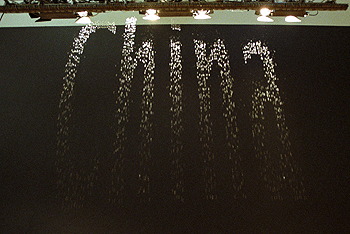The grid — a simple arrangement of individual elements into perpendicular lines — is a familiar and fundamental pattern, a cornerstone of urban planning and industrial production.
Yet in recent years, use of the three-dimensional matrix — an essential element of digital media — has extended the grid into new and often unpredictable dimensions, reshaping our daily experience of culture, communication and self-expression.

[Grid‹›Matrix], on view through Dec. 31 in the Mildred Lane Kemper Art Museum’s Special Exhibitions Gallery, investigates both ruptures and continuities between the grid and the matrix, exploring how these two distinct yet related modes of visual organization have influenced our understanding of aesthetics, art and media since the early 20th century.
Drawn from private collections and major museums, [Grid‹›Matrix], is curated by Sabine Eckmann, Ph.D., museum director and chief curator, and Lutz Koepnick, Ph.D., professor of German and of film and media studies, both in Arts & Sciences.
It includes work by 15 artists, ranging from classical modernists such as Piet Mondrian, Theo van Doesburg and Laszlo Moholy-Nagy to major mid-century artists such as Dan Flavin, Agnes Martin, Robert Rauschenberg and Andy Warhol to important contemporary figures like Albert Oehlen, Julius Popp and Jeffrey Shaw.
Early use of the grid — in paintings such as van Doesburg’s “Composition VII: The Three Graces” (1917) and Mondrian’s “Composition of Red and White” (1938-1942) — often reflects a sense of technological possibility while emphasizing the purity and autonomy of the abstract image.
By contrast, Warhol’s silkscreen canvas “Twenty Blue Green Maos” (1979) and Flavin’s fluorescent light sculpture “Untitled (in honor of Leo at the 30th anniversary of his gallery)” (1987) employ the grid as a means of introducing industrial processes and materials into the sphere of high art.
The grid continues to play an important role in computer-based work such as digital photography, which subdivides images into grids of individual pixels. Yet it is the matrix — which sets the modernist grid into motion — that has become truly emblematic of current digital culture. For example, Shaw’s “The Legible City” (1988-1991) uses plans for actual cities to create a virtual structure composed of words and letters and broadcast onto large screens through which visitors navigate by “riding” an interactive stationary bicycle.
Other contemporary artists employ the matrix to highlight the immaterial, the ephemeral and the passage of time. Oehlen’s “The Annihilator” (2001/06) combines matrix-based patterns with freehand painterly gestures to explore affinities between abstract painting and digital technology. Popp’s “Bit.Fall” (2001-05) employs water droplets and a complex, computer-controlled valve system to create an enormous, ever-changing water wall of frequently used Internet search terms.
In conjunction with [Grid‹›Matrix], Christiane Paul, adjunct curator of new media arts at the Whitney Museum of American Art in New York, will speak on “Grid vs. Network: Aesthetics of New Media Spaces” at 7:30 p.m. Nov. 30 in Brown Hall, Room 100.
Also on view in the Special Exhibitions Gallery is Models and Prototypes, which investigates the growing importance of the model as a visual strategy since the early 20th century.
As Western art has moved away from straightforward depictions of the natural universe, models and prototypes have evolved from preparatory steps in the creative process to become increasingly autonomous works of art, redefining artistic practice.
Drawn predominantly from the permanent collection, the exhibition is organized by Catharina Manchanda, Ph.D., museum curator, and arranged in three sections: Conceptual Models, The Multiple as Model and Structural Models. In all, it features 34 works by 25 artists, ranging from modernist pioneers such as Le Corbusier, Marcel Duchamp and Wassily Kandinsky to major contemporary figures such as Daniel Buren, Isa Genzken, Jenny Holzer, Joseph Kosuth and Edward Ruscha.
Conceptual Models, which emerged as an outgrowth of abstraction, are typically characterized by the use of ordering systems, often derived from mathematics, language or other visual signs. For example, Alfred Jensen’s “Great Mystery I: The Origin of the Chinese Decimal System” (1960) is based on the “divine” Lo Shu diagram, while Hannah Weiner’s “Signal Flag Poems” (1968) draws on the communication system for ships at sea.
The Multiple as Model highlights works by artists who questioned the validity of the original artwork. Examples include Duchamp’s “Pocket Chess Set” (1944), one of a series of editioned pieces that followed his influential ready-made objects, and Joseph Beuys’ “Noiseless Blackboard Eraser” (1974), an edition ready-made from his famous “Energy Plan for the Western Man” lecture tour.
The final section, Structural Models, hinges on the use and/or deconstruction of architectural or topographic forms, as in Genzken’s “Little Crazy Column” and “Bill II” (2001 and 2002), which recall modernist skyscrapers, and Katrin Sigurdardottir’s “The Green Grass of Home” (1997), which conflates the parks of her native Reykjavik, Iceland, with spaces in San Francisco and Berkeley, Calif., and New York. Other examples include Joseph Cornell’s assemblage boxes of the 1940s, as well as proposals by Mark Bennett and Claes Oldenburg that bridge real and imagined spaces.
Both [Grid‹›Matrix], and Models and Prototypes are free and open to the public. Hours are 11 a.m.-6 p.m. Mondays, Wednesdays and Thursdays; 11 a.m.-8 p.m. Fridays; and 11 a.m.-6 p.m. Saturdays and Sundays. The museum is closed Tuesdays.
For information, call 935-4523 or e-mail kemperartmuseum@wustl.edu.